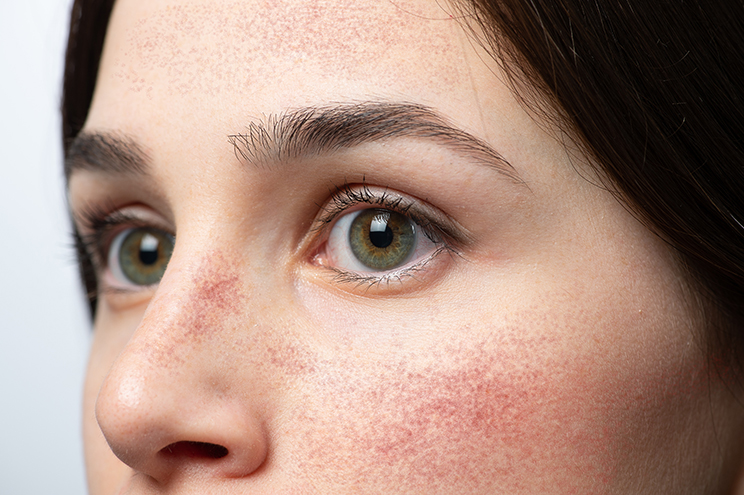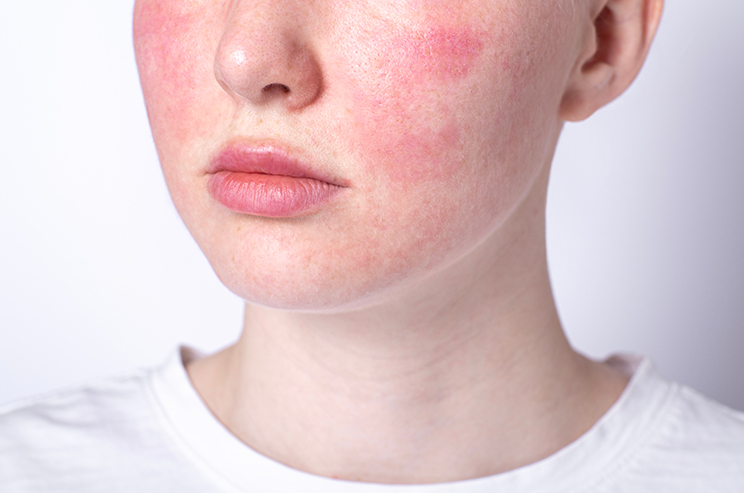Couperosa ja ruusufinni - punoitusta ja herkkyyttä iholla

Couperosa ja sen vakavampi muoto, ruusufinni, ovat iho-ongelmia, jotka ilmenevät kasvojen punoituksena, laajentuneina verisuonina ja ihoärsytyksenä.
Couperosa-iho, jota esiintyy erityisesti poskissa, nenässä ja leuassa, on tyypillisesti herkkä ja helposti reagoiva. Ruusufinni eli rosacea, couperosan laajempi ja tulehduksellisempi muoto, aiheuttaa kutinaa, kuivuutta ja ärsytystä. Sen oireet voivat vaihdella lievistä punoittavista alueista papulopustulaariseen ruusufinniin, jossa ihoon muodostuu kivuliaita märkänäppyjä.
Punoittava iho, ihon kutina ja kuivuminen ovat yleisiä oireita, jotka voivat johtaa epämukavuuteen ja vaativat usein erityistä hoitoa. Couperosa ja ruusufinni ovat molemmat kroonisia, mutta niiden oireita voidaan hallita ja lievittää oikeilla hoitokeinoilla ja tuotteilla.
Couperosan ja ruusufinnin oireet ja vaiheet
Couperosa-iho ja ruusufinni johtuvat yleensä sekä perinnöllisistä tekijöistä että ympäristöstä. Couperosassa kasvojen pintaverisuonet laajenevat ja menettävät kimmoisuuttaan, jolloin ne jäävät näkyviin ihon pintaan. Syinä voivat olla auringon UV-säteily, vaihtelevat lämpötilat, kuiva ilmasto ja kova tuuli, jotka kaikki ärsyttävät herkkää couperosa-ihoa.
Nämä ulkoiset tekijät vaurioittavat ihon suojakerrosta, jolloin ihoärsytys, ihon kutina ja ihon punoitus voivat lisääntyä. Lisäksi elämäntapatekijät, kuten runsas alkoholin käyttö, mausteinen ruoka ja kuumat juomat, voivat pahentaa couperosaa. Esimerkiksi alkoholi laajentaa verisuonia, mikä voi lisätä punoitusta ja couperosan oireita.
Ruusufinniä taas pidetään osittain tulehdusperäisenä ongelmana, jossa iho reagoi herkästi erilaisiin ulkoisiin ja sisäisiin ärsykkeisiin, mikä johtaa verisuonitulehdukseen ja punoitukseen. Ruusufinni liittyy usein myös hormonaalisiin muutoksiin, erityisesti naisilla, mutta sitä esiintyy myös miehillä.
Miehillä ruusufinni ilmenee usein nenän alueella, jossa verisuonet voivat laajentua pysyvästi, aiheuttaen voimakkaampaa turvotusta ja ihon paksuuntumista. Ruusufinnin kutina ja kuiva iho voivat myös lisätä iho-ongelmia, mikä vaikeuttaa ihonhoitoa ja saattaa vaatia lääkärin määräämiä hoitokeinoja.
Monet herkkäihoiset kärsivät couperosa- ja ruusufinnioireista, sillä heidän ihonsa reaktiivisuus ulkoisiin ärsykkeisiin on korkeampi. Herkkä iho voi helposti kuivua, jolloin iho kutisee, punoittaa ja tuntuu epämukavalta. Ilman hoitoa couperosa voi edetä ajan myötä ruusufinnin vakavampiin muotoihin, joten oikea-aikainen ihonhoito on erityisen tärkeää couperosa ihon hoidossa.

Couperosan ja ruusufinnin oireet ja vaiheet
Couperosalla on erilaisia ilmenemismuotoja ja vaiheita, jotka voivat vaihdella lievästä punoituksesta huomattavasti näkyvämpiin oireisiin. Lievä couperosa-iho voi esiintyä yksinkertaisesti herkkyytenä ja satunnaisena punoituksena, kun taas vaikeammissa tapauksissa verisuonet ovat selvästi näkyviä ja iho tuntuu jatkuvasti ärtyneeltä.
Ruusufinni, couperosan vakavampi muoto, etenee tyypillisesti neljän vaiheen kautta:
- Erytromatotelaangiektinen – Tämä vaihe alkaa kasvojen ajoittaisella punoituksella ja lievällä turvotuksella. Kasvojen iho ärsyyntyy helposti, ja kasvojen verisuonet voivat tulla näkyviin erityisesti poskien alueella. Kutina ja ihon kuivuus voivat olla jatkuvia ongelmia tässä vaiheessa.
- Papulopustulaarinen – Tässä vaiheessa ihoon alkaa ilmestyä märkänäppyjä, ja tulehdus leviää kasvojen alueella, erityisesti poskissa ja nenässä. Tämä vaihe voi olla kivulias ja aiheuttaa kutinaa, joka johtuu tulehtuneesta ihosta. Iho voi tuntua turvonneelta ja punoittaa voimakkaasti.
- Rinofyyma – Ruusufinnin edetessä iho paksuuntuu, erityisesti nenän alueella, ja verisuonet laajenevat entisestään. Tämä vaihe on yleisempi miehillä, ja se voi johtaa pysyviin iho-ongelmiin, kuten nenän turpoamiseen ja verisuonten laajenemiseen.
- Okulaarinen – Ruusufinni voi olla myös silmässä, aiheuttaen niissä kutinaa, kuivuutta ja ärsytystä. Silmäluomet voivat tuntua aralta ja silmät punoittavat. Tämä vaihe voi olla erityisen epämukava ja vaatii usein lääkärin määräämiä hoitotoimenpiteitä.
Ruusufinnin oireet voivat vaihdella henkilökohtaisesti, ja ne voivat pahentua tai helpottua ajan myötä. Couperosa voi pysyä lievänä vuosikausia, mutta ilman hoitoa se voi edetä ruusufinnin vakavampiin muotoihin.

Couperosan ja ruusufinnin hoitokeinot
Couperosan ja ruusufinnin hoito edellyttää erityisesti herkälle iholle soveltuvia, rauhoittavia tuotteita ja hoitomuotoja. Koska couperosa-iho reagoi herkästi voimakkaisiin ainesosiin, on suositeltavaa välttää alkoholia ja hajusteita sisältäviä tuotteita.
Hoidettaessa couperosaa on suositeltavaa aloittaa ei-invasiivisella ja hellävaraisella ammattilaishoidolla, ja tehostaa käsittelyä vähitellen ihon kunnon mukaan. Laite- ja injektiohoidot vahvistavat ja kiinteyttävät ihoa, stimuloivat kollageenin tuotantoa ja tukevat ihon verisuonirakenteen palautumista, mikä parantaa merkittävästi ihon rakennetta ja sen vastustuskykyä ulkoisia ärsykkeitä vastaan.
Tällainen hoitopolku mahdollistaa parhaat tulokset minimaalisilla riskeillä ja ilman merkittävää epämukavuutta. Tässä muutamia tehokkaita hoitokeinoja:
- EXION Fractional RF: RF-mikroneulaus stimuloi ihon syvempiä kerroksia ja edistää kollageenin muodostusta, mikä vähentää punoitusta ja tasoittaa ihon rakennetta.
- EXION Clear RF: Vähentää punoitusta, supistaa pintaverisuonia ja vahvistaa ihon suojakerrosta. Hoito tasoittaa ihon sävyä ja tekee siitä kestävämmän ulkoisia ärsykkeitä vastaan.
- PRP-plasmahoito: Hyödyntää potilaan omaa veriplasmaa kiihdyttämään ihon uusiutumista ja vähentämään sen punoitusta. Koska PRP ei ärsytä herkkää couperosa-ihoa, se on monille hyvä valinta punoituksen vähentämiseen ja ihon rauhoittamiseen. PRP hyaluronihappohoito kiinteyttää ja kosteuttaa ihoa.
- Mesoterapia: Pienet mikroinjektiot vievät ihoa vahvistavia ja rauhoittavia vaikuttavia aineita suoraan ihon pintakerrokseen. Tämä parantaa mikroverenkiertoa, vähentää punoitusta ja kosteuttaa ihoa.
- Biorevitalisaatio: Runsaasti hyaluronihappoa sisältävät pistokset kosteuttavat ja vahvistavat ihoa syvältä. Vahvempi ja kimmoisampi iho reagoi vähemmän ärsykkeisiin ja punoitus rauhoittuu.
- AestheFill: AestheFill-hoito voi auttaa couperosan ja ruusufinnin hoidossa epäsuorasti, koska se stimuloi kollageenin tuotantoa ja vahvistaa ihon tukirakenteita. Kun iho on paksumpi ja kestävämpi, pintaverisuonet eivät näy yhtä selvästi ja ihon punoitus rauhoittuu.
- Couperosa-laserhoidot: Couperosa-laserhoidoissa käytetään valoa vähentämään näkyviä verisuonia ja kasvojen punoitusta. Laserhoito voi tehokkaasti vähentää couperosa-ihon oireita ja parantaa ihon ulkonäköä, ja se sopii erityisesti laajentuneiden verisuonten hoitoon poskissa ja nenässä.
Couperosan ja ruusufinnin hoito on pitkäjänteistä ja vaatii säännöllistä ihonhoitoa. Ihoärsytyksen välttäminen, kosteuttaminen ja punoituksen lieventäminen auttavat ehkäisemään couperosa-ihon ja ruusufinnin pahenemista ja pitämään ihon tasaisempana ja rauhallisempana.
MESQ®
DoctusPlus Oy:n aputoiminimi
Yritys
DoctusPlus Oy
Y-tunnus
3154088-6
Käyntiosoite
Itämerenkatu 11-13 F, 00180 Helsinki
Puhelin
Sähköposti
Aukioloajat
Ma – Pe 11:00 – 19:00